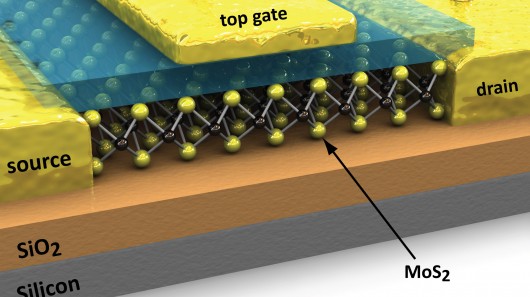Researchers have uncovered a material that they say has distinct advantages over traditional silicon and even graphene for use in electronics.
Called molybdenite (MoS2), this mineral is abundant in nature and is commonly used as an element in steel alloys or, thanks to its similarity in appearance and feel to graphite, as an additive in lubricant. But the mineral hadn’t been studied for use in electronics, which appears to have been an oversight with new research showing that molybdenite is a very effective semiconductor that could enable smaller and more energy efficient transistors, computer chips and solar cells.
Researchers from Ecole Polytechnique Fédérale de Lausanne (EPFL) say one of molybdenite’s advantages over silicon is its thinness. With an atomic structure consisting of a sheet of molybdenite atoms sandwiched between sheets of sulfur atoms, molybdenite is less voluminous than silicon.
“It’s a two-dimensional material, very thin and easy to use in nanotechnology. It has real potential in the fabrication of very small transistors, light-emitting diodes (LEDs) and solar cells,” says EPFL Professor Andras Kis. “In a 0.65-nanometer-thick sheet of MoS2, the electrons can move around as easily as in a 2-nanometer-thick sheet of silicon,” adds Kis, “but it’s not currently possible to fabricate a sheet of silicon as thin as a monolayer sheet of MoS2.”









